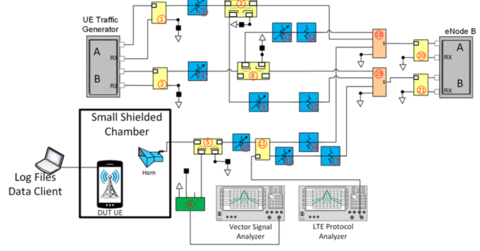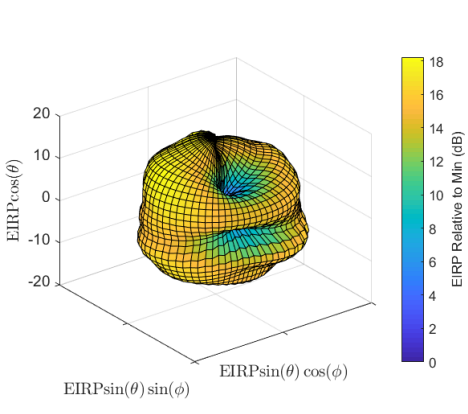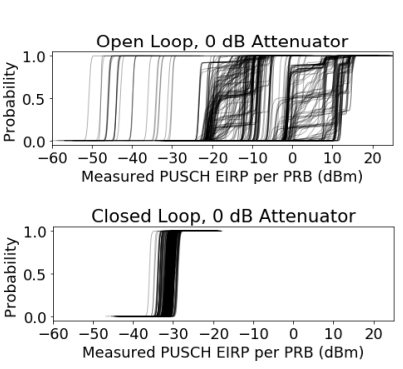Summary
This project characterizes cellular emissions (LTE uplinks) to support interference models used to coordinate commercial carrier deployments in the AWS-3 band (1755-1780 MHz band) with DoD systems that remain in the band. This effort consisted of two parts: (1) a Factor Screening effort which identified the key factors impacting emissions, and (2) characterization of factors impacting UE uplink emissions when closed-loop power control is enabled in the cell, and models of the emissions over operational scenarios.
Description
Designed, demonstrated and validated a test methodology for measuring aggregate emissions over a wide range of condition. Several factors were evaluated, including the collective power distributions emitted by the UEs in a cell, the number of UEs transmitting simultaneously, the spectral properties of the UEs, channel characteristics on the path between the UEs and unintended receivers, and other special conditions relevant to the test environment. Measurements were conducted in a controlled lab environment to produce baseline reference variables for network configuration and accurate assessment of impact dependencies. The output of this work can aid in the development of emissions models and interference calculations in the AWS-3 band and beyond.
Part 1: The Factor Screening experiment was conducted with 28 factors (e.g., eNB power control variables, eNB scheduling algorithms, network loading, traffic type, etc.) to determine which factors have a significant impact on physical uplink shared channel (PUSCH) power per physical resource block (PRB). The results demonstrate the validity of the proposed test methodology and illustrate how factor screening experiments can be used to better understand the emissions of typical commercial off-the-shelf LTE UEs. (Characterizing LTE User Equipment Emissions: Factor Screening)

In support of this study, a separate independent effort captured and documented UE antenna 3D pattern measurements. (LTE Handset Emissions: Radiation Pattern Measurements)

Another contribution to this study is a MITRE Corporation report which informs the project with an understanding of real-world LTE network path loss and propagation characteristics. (Investigations and Analyses of LTE Network Cell Tower Deployments and Impact on Path Loss Calculations)
Part 2: Emissions of UEs under Closed Loop Power Control determined which factors have a significant impact on the distribution of physical uplink shared channel (PUSCH) power per physical resource block (PRB) under closed-loop power control conditions. A model of the emissions over operational scenarios was also developed. (Characterizing LTE UE Emissions Under Closer-Loop Power Control)

Background: The 2014 AWS-3 spectrum auction assigned 1755-1780 MHz frequencies to commercial wireless carriers with conditions for sharing the spectrum with existing federal systems. As carriers develop network buildouts in this band, the Defense Information Systems Agency (DISA) Defense Spectrum Organization (DSO) is engaged in a broader effort to assess interference risk between commercial systems and the incumbent DoD systems that remain in the 1755-1780 MHz band. Aggregate LTE User Equipment emissions were identified as one potentially influential factor. The NASCTN effort characterizes LTE uplink waveforms generated by User Equipment (UE) in the AWS-3 1755-1780 MHz band with the intent to make realistic measurements of UE emissions. These measurements are used for assessing interference to DoD systems that, for a time, will remain in the 1755-1780 MHz band. Additionally, the data will provide AWS-3 stakeholders more confidence in the DISA DSO Coordination Request Evaluation (CRE) process, and may affect the business strategy and network design of commercial deployments during the time federal systems continue to operate in the 1755-1780 MHz band.
Project Time Table
| Framework Stage | Information |
|---|---|
| Stage 4: Summarize Findings |
LTE Handset Emissions: Radiation Pattern Measurements Final Test Report Characterizing LTE User Equipment Emissions: Factor Screening Characterizing LTE User Equipment Emissions Under Closed-Loop Power Control |
| Stage 3: Test Execution | |
| Stage 2: Test, Metrology, and Implementation Plan | |
| Stage 1: Proposal Screening | Proposal Submitted by DSO. Approved by NASCTN Steering Committee. |
For more information, please contact us at nasctn [at] nist.gov (nasctn[at]nist[dot]gov).

